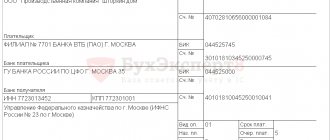What is the tax rate?
Let's study the features of such a phenomenon as the tax rate. This term most often refers to accruals per unit of measurement of the corresponding base for a particular type of collection to the budget. Tax rates are most often expressed using percentages. For example, the personal income tax rate in Russia is 13%, VAT - 18%.
In some cases, the corresponding indicator is defined in the form of decimal numbers. For personal income tax and VAT it will be 0.13 and 0.18, respectively. Laws may also provide for a 0 tax rate (zero) for Russian taxpayers. This can be observed in the example of zero VAT for enterprises operating under the simplified tax system. Next we will look at this feature in more detail.
Article 53 of the Tax Code of the Russian Federation. Tax base and tax rate, fees (current version)
The commented article defines such elements of taxation as the tax base and tax rate.
Taxes are calculated on the basis of the tax base, which recognizes the cost, physical or other characteristic of the object of taxation, the tax rate, which recognizes the amount of tax charges per unit of measurement of the tax base, as well as tax benefits (to which Article 56 of the Tax Code of the Russian Federation is devoted).
The Resolution of the Sixth Arbitration Court of Appeal dated October 9, 2012 N 06AP-4454/2012 states that since the tax base is the basis for calculating the amount of tax, since the tax rate is applied to it, the procedure for calculating the tax base is regulated by tax legislation.
The Resolution of the Eleventh Arbitration Court of Appeal dated 05/03/2012 N A72-7556/2011 noted that based on the definition of the tax base given in Article 53 of the Tax Code of the Russian Federation, as a cost, physical or other characteristic of the object of taxation, it can be argued that in the absence of an agreement with the counterparty It is also impossible to determine the tax base, since it is secondary in relation to the object of taxation and must also have a cost characteristic.
As explained in the Resolution of the Federal Antimonopoly Service of the Ural District dated January 17, 2013 N F09-13153/12, the legislation on taxes and fees of the Russian Federation does not provide for the determination of the tax base and, accordingly, the amount of taxes payable to the budget, only on the basis of information contained in the registers accounting, as well as tax reporting submitted to the tax authority.
The correctness of the data reflected in the accounting and tax reporting must be confirmed by relevant primary documents.
If discrepancies are identified between tax returns and accounting registers, the tax official conducting the audit must determine the reason for such discrepancy.
To do this, the taxpayer’s primary documents, which serve as the basis for the calculation and payment of tax, must be checked. Based on these documents, it is determined which document - tax return or accounting register - does not correspond to the primary documents. Only after this is it possible to determine whether the identified discrepancy led to non-payment (incomplete payment) of tax. In this case, all documents and information available to the taxpayer related to his economic activities must be taken into account.
In addition, the very fact of discrepancies between the data of the tax return and the accounting registers (turnover balance sheets) can only indicate a violation by the taxpayer of the rules for accounting for income and expenses and objects of taxation, which in itself cannot be a basis for the tax authority’s refusal to accept the tax base for income tax in the amount specified by the taxpayer.
Comment source:
“ARTICLE-BY-ARTICLE COMMENTARY TO PART ONE OF THE TAX CODE OF THE RUSSIAN FEDERATION” (UPDATE)
Yu.M. Lermontov, 2016
Types of bets
Let's look at the main types of tax rates. In world economic science there are a large number of approaches to determining the relevant indicators.
Among the most common grounds for classifying tax rates is the degree of burden for the payer. Within this criterion, indicators can be:
- basic (these are rates that do not imply that the payer is classified into any specific category for the purpose of applying benefits and other preferences);
- reduced (these are indicators that are determined, in turn, taking into account the preferential or preferential status of the taxpayer, up to a zero tax rate);
- increased (this type of rate assumes that the payer’s activities are characterized by characteristics that give the state the right to levy more taxes from him).
Another basis for the classification of the indicators under consideration is the method of their establishment. So, tax rates can be:
- absolute (they assume that the amount of the fee is determined for each of the taxation units in fixed values);
- relative (their value is directly proportional to the size of the taxation unit).
If we talk about the tax system of the Russian Federation, then we can highlight such a basis for classifying rates as classifying a tax as federal, regional or local. Thus, the jurisdiction for approving the relevant indicators will vary. For federal taxes, rates are determined by the highest government bodies, for regional ones - by the relevant structures at the level of the constituent entity of the Russian Federation, for local ones - by municipal institutions.
Differences from the direct method
Unlike the direct method of taxation, the proportional method establishes an equal tax rate for all taxpayers, and not the amount of tax. With the growth of the tax base, the amount of tax increases proportionally, the tax rate remains unchanged. In the current tax system of the Russian Federation, the method of proportional taxation is used quite actively. An example of the use of this method is the income tax of enterprises and organizations. The tax rate is the same for payers with profits of any size, regardless of the type of activity and form of ownership.
Proportional taxation is the result of the struggle for fair taxation, it was enshrined in tax practice by the French Revolution and is based on the idea of equality. The idea of equality certainly presupposes the following principles of taxation: universality; equal taxation; uniform distribution of the tax burden between taxpayers; fair taxation according to everyone's means.
Basic tax rates in the Russian Federation
Let's study the main tax rates established by the Tax Code of the Russian Federation. Among the most common types of fees to the Russian budget:
- personal income tax;
- on the profits of organizations;
- VAT;
- for revenue (profit) according to the simplified tax system;
- UTII;
- transport tax;
- property tax for organizations;
- property tax for citizens;
- land tax.
Let's study their specifics in more detail.
Personal income tax
Tax rates for personal income taxes, or personal income tax, in Russia are 13% for residents of the Russian Federation, 30% for citizens who do not have such status. The criterion by which payers belong to the first category is that they are in Russia for most of the days of the year. It does not matter whether a person is a citizen of the Russian Federation or a foreigner.
Personal income tax in Russia is paid on a wide variety of income that a person receives: from wages, contract work and services, sales of property, etc. The peculiarity of this tax is that various deductions are established for it - social, property, standard. That is, a citizen paying personal income tax has the opportunity to reduce the corresponding fee on the grounds provided by law.
The personal income tax rate, based on the grounds for classification defined above, can be classified as basic and relative. At the same time, if the payer does not have the status of a resident of the Russian Federation, then it may well be classified as increased, since its amount increases by more than 2 times.
The procedure for establishing local taxes and fees
The enactment and cancellation of a particular local tax (fee) is carried out according to the rules prescribed by the domestic tax code, on the basis of legislative decisions of bodies performing representative functions at the basic level. This competence of local authorities is enshrined in Article 39 of the federal law “On the General Principles of the Organization of Local Self-Government.” According to this norm, local authorities have the right to establish (cancel):
- local taxes (fees);
- preferential conditions for local taxation for certain categories of payers.
In addition, one-time contributions of funds to the local budget by citizens living in a certain territory on a voluntary basis may be provided.
Voluntariness consists of citizens expressing their will at a local referendum, meeting, etc.
Collection of land and property taxes is also carried out after the relevant decision is made at the local level. Moreover, such a decision should not contradict the federal tax code.
Corporate income tax
This tax is paid mainly by large businesses with high turnover. Small and medium-sized enterprises are trying to work in the simplified taxation system. For this fee, tax rates in 2020 are 20% for all types of enterprise income. The legislation does not define any benefits for organizations that are obliged to make appropriate transfers to the budget, as when paying personal income tax for certain categories of payers.
Based on the grounds for classifying rates that we defined above, the one established for income tax can be classified as basic and relative.
What is the proportional tax system?
Pros and Cons Proportional taxation is intended as a popular method of calculating taxes in a case in which all taxpayers pay tax at an equal rate. The rate is identical to everyone and does not depend on the income of a particular payer. As the base grows, the tax also increases in equal proportions. As an example of the proportional taxation system in Russia, it is possible to call the income tax applied to legal entities. The rate is always fixed and can only be changed by government resolutions. The system was evaluated by the American economist Adam Smith, who opined that it allows citizens to participate in the financial situation of the state according to individual capabilities. In the Russian Federation, most taxes are based on a proportional system. The principle was inherited in European countries.
Taxes under the simplified tax system
The simplified taxation system, or simplified taxation system, is an interesting phenomenon. This type of fee is designed to significantly reduce the tax burden for enterprises, this is especially important for start-up businesses. Actually, it can only be used by those organizations whose turnover is relatively small - within 60 million rubles. in year. The legislation of the Russian Federation defines 2 types of rates for the simplified tax system: when collecting tax on an enterprise’s revenue - 6%, when collecting taxes on profits - 15%. The entrepreneur himself chooses one of the two indicated payment schemes with the state.
For enterprises operating under the simplified tax system, as we noted above, the tax rate for VAT is set to 0. However, a company can independently generate documents that may result in an obligation to pay the appropriate fee. Value added tax can be classified as basic and relative.
The rates established for the simplified tax system can be classified as reduced (they are established as an alternative to those established for income tax) and relative. But some lawyers still tend to classify them as basic, since the corresponding fee belongs to a separate category.
Calculation formula, application in Russia
The proportional system implies that people with different incomes pay an equal percentage of them, so the calculations are reduced to a simple formula. The tax rate is divided by 100 and multiplied by income.
For example, if a cleaner receives 15,000 rubles, then at a rate of 13% the tax amount will be 1,950 rubles (15,000 x 0.13 = 1,950). If your income increases, the amount will increase in proportion. In Russia, a significant part of total tax profits is made up of the following types of taxes: 1. on profit. 2. On added value. 3. Payments in non-state funds. 4. Excise taxes. The federal budget of the Russian Federation is filled in many respects through value added tax. Since the last decade's receipts from other sources have changed greatly. For example, profits from the sale of energy resources have always depended on their prices on the world market and the political situation. Profit from taxation is much more permanent and also has an increased share.
Simplified tax system and fees to state funds for individual entrepreneurs
It will be useful to study the correlation between the simplified tax system and fees to state funds - the Pension Fund and the Federal Compulsory Medical Insurance Fund, which individual entrepreneurs pay for themselves. These payments are made by individual entrepreneurs regardless of whether they have a profit or not. Therefore, the corresponding type of taxes can be classified as absolute, since their value is fixed (determined for the year). For example, in 2020 the corresponding amount is about 22 thousand rubles. The peculiarity of the legislative regulation of the payment of fees to state funds is that these payments can be fully offset against the payment of taxes by individual entrepreneurs according to the simplified tax system. In fact, a 0 tax rate for the simplified tax system is formed. This useful feature is very positively assessed among Russian entrepreneurs.
Taxes in case of simplified tax system
The simplified tax system or simplified tax system is the most interesting phenomenon. This type accuses and is convinced to significantly reduce the tax burden for enterprises, this is especially important for start-up companies. In fact, only those organizations whose turnover is quite small - at 60 million rubles per year - can use it. The legislation of the Russian Federation has determined 2 types of rates for the simplified tax system: in the case of a set tax on enterprise income - 6%, in the case of expenses from profit - 15%. The entrepreneur himself chooses one of the two indicated payment schemes with the state.
For enterprises operating under the simplified tax system, as we noted above, 0 VAT tax rates are established. However, a firm may independently create documents as a result of which it may have liability for payment of the relevant set. Value added tax can be applied to basic and relative. The rates established for the simplified tax system can be reduced (they are established as an alternative to those established for income tax), and relative. But some lawyers nevertheless tend to classify them as basic, since the corresponding set belongs to a separate category.
UTII
Some companies operating in the Russian Federation prefer to operate under the UTII (single tax on imputed income) regime. The rate for this type of fee is established by federal law; currently it is 15%. But besides this, the formula for calculating this tax uses basic profitability, physical indicators, as well as coefficients K1 and K2. What are the specifics of the legal regulation of this fee? Basic profitability, physical indicators and the first coefficient are established in federal laws, the second - in regional ones. The operation of an enterprise in the UTII mode assumes that it pays a fixed fee to the budget regardless of income. The rate for this tax therefore refers to absolute and basic.
Transport tax
The transport tax, which falls into the regional category, is interesting. The rate for it can be determined based on a variety of criteria: the year of manufacture of the car or other vehicle, engine power, capacity, classification into a particular category. Theoretically, some of the relevant indicators established by the legislation of different regions can vary very significantly. For example, for passenger cars with an engine with a power of up to 100 horsepower, the transport tax rate can range from 1 to 25 rubles. for one liter With. However, the indicators in question can be reduced or increased by the authorities of the constituent entities of the Russian Federation by no more than 10 times relative to the figures recorded in the Tax Code of the Russian Federation.
The transport tax rate can be classified as relative and basic. But the law provides grounds that allow in some cases to classify certain types of relevant indicators for a given fee as increasing or decreasing.
Property tax for organizations
Enterprise property tax is classified as regional. What does it mean? First of all, the tax rate on property is fixed at the level of laws of the constituent entities of the Russian Federation. However, the Tax Code defines its maximum indicator - 2.2%. The property tax is paid by: Russian organizations (if they own movable and immovable property recorded on the balance sheet), foreign companies (if they own real estate).
If we compare the fee in question and the types of tax rates we defined at the beginning of the article, then we can classify the corresponding indicator as relative and basic.
Benefits when using the tax rate in 2019
Those individuals who fall into the preferential category have the opportunity to use the right of relief only for one unit of real estate out of all available.
The following groups of individuals fall into the preferential category:
heroes of the USSR and Russia;- veterans of the Second World War and the war in Afghanistan, as well as military personnel who served in special risk units;
- people with disabilities of groups 1 and 2 since childhood;
- nuclear weapons testers;
- participants in eliminating problems after radioactive disasters;
- pensioners;
- military pensioners with 20 years of service;
- relatives of military personnel who were left without a breadwinner;
The benefit applies to apartments that do not provide commercial benefits, i.e. are not for rent and are not retail space for shops, salons, etc.
To receive the benefit, you must write an application to the tax office at your place of residence. You should also provide documents that would confirm that you belong to a preferential category.
Important fact
Large families and single mothers are NOT eligible to receive tax benefits.
The tax-free area for an apartment is 20 m2 (for a residential building - 50 m2, for a room - 10 m2). If, when deducting the non-taxable area, the owner of the apartment (house, room) comes up with “zero”, then the owner is not obliged to pay the tax amount. In this case, regional authorities must draw up an act that will contain a list of individuals who have the right not to pay apartment tax.
Property tax for citizens
The need to pay property tax is established by the legislation of the Russian Federation also in relation to citizens. This obligation must be fulfilled in particular by the owners of apartments, rooms and houses. Real estate tax rates for citizens are set by municipal authorities - in the range of 0.1-0.3% of the cadastral value of housing.
At the same time, until 2020, the formula for calculating the corresponding payments will use reducing coefficients to make it easier for citizens to adapt to this tax burden. Also, when determining the amount of property fees for citizens, deductions are used in the form of reducing the area of housing by a given number of square meters and a proportional reduction in its cadastral value.
In accordance with the classification we noted, property tax rates for citizens can be classified as relative and basic. The fee in question is classified as local. Land tax also belongs to this category. Let's study its specifics.
System of local taxes and fees
The system of local taxes and fees is also provided for by the Tax Code of the Russian Federation and is represented by an exhaustive list of both taxes and fees. State power represented by local government cannot go beyond this list and establish additional fees or local taxes.
Local taxes are presented in the form of taxes:
- federal;
- regional;
- local, put into effect by the self-government body within the municipality.
Local fees include:
- Federal level;
- local level.
Within the region, the introduction of fees is not provided for by the Tax Code of the Russian Federation, and accordingly is unacceptable, which is why the system of fees throughout the country is represented by two levels.
Land tax
As in the case of property tax for citizens, the rates for the fee in question are fixed in municipal legal acts. Their value cannot exceed 1.5% when it comes to lands: used in agriculture, in housing construction, as well as as summer cottages and garden plots. For other categories of land, the maximum value of the indicator is 0.3%.
The rates for the fee under consideration can be classified as relative and basic. Some lawyers consider the figure of 0.3% to be reducing.
What is apartment tax and what does it depend on?
Property tax is required to be paid by private individuals who own the following real estate:
- garages, parking spaces;
- apartments, houses and rooms;
- unified real estate complexes;
- unfinished construction projects;
- shared ownership of any property listed above.
The most common property option for private individuals is an apartment.
Apartment tax is a local tax, regulated until the beginning of 2020 by a separate federal law “On taxes on property of individuals” No. 2003-1 of December 9, 1991.
On January 1, 2015, Federal Law No. 284 of December 4, 2014 came into force, which introduces an additional chapter 32 “Property tax for individuals” into the Tax Code of the Russian Federation.
The cadastral value (that is, as close as possible to the market value) of the property of the taxable object is established as the tax base. Before the adoption of regulatory innovations, the calculation took into account the inventory value of the apartment.
Today you can find out information about the cadastral value of an apartment on the Internet in several ways:
- if the cadastral number is unknown, then on the Rosreestr website in the appropriate section, enter the address of the apartment, at which the state cadastral number is displayed;
- if the cadastral number is known, then you need to enter it on the tax office website and see the cost.
You can additionally clarify the size of the cadastral value of real estate at the MFC and at the cadastral chamber of Rosreestr.
The new rules for calculating apartment tax are applied to each subject of the Russian Federation on an individual basis.
Those regions that, before December 1, 2015, did not manage to establish the cadastral value of real estate and publicly disclose such data in the relevant legislative act, will apply the previous calculation scheme when making payments in 2016.
At the same time, all regions of Russia must fully switch to calculating apartment taxes using the new method, taking into account the cadastral value, before January 1, 2020.
The tax on a house or apartment is calculated by the tax office at the place of registration of the taxpayer and is received by him in the form of a tax notice containing information about the amount and terms of payment.
Due to the fact that the person tax under consideration is a local level tax, the specific rate is determined in each municipality separately. In accordance with the new law, the following restrictions on tax rates have been adopted:
- no more than 0.1% of the cadastral value of taxable objects, as well as utility buildings with an area of no more than 50 square meters. m.;
- no more than 2% for a certain list of taxable objects listed in the Tax Code of the Russian Federation (clauses 7, 10 of Article 378), and objects with a value of more than 300 million rubles;
- no more than 0.5% for the rest of the property.
The authorities of some municipalities, such as, for example, Moscow, Crimea, St. Petersburg and others, have the right to reduce the tax rate of 0.1% to 0 or, conversely, increase it, but not more than 3 times .
The legislation allows the use of differentiated rates depending on the following parameters:
- Type of taxable object.
- Location of the object.
- Cadastral value.
- Type of territorial zone within which the taxable object is located.
During the tax calculation process, depending on the types of objects, the cadastral value may be reduced by the amount of the tax deduction.
At the federal level, a deduction is established for apartments in the equivalent of the cost of 20 square meters. m. of this apartment. It is this number of meters that will not be subject to taxation.
If the cadastral value is negative, it is equal to 0 in accordance with accepted rules.
Municipal authorities are given the right to increase the amount of tax deduction at their discretion.
Changes in tax legislation in 2020
So, in Russia a wide variety of types of fees and corresponding tax rates have been approved. 2020 is characterized by noticeable legislator activity in terms of adjusting these indicators - at one level or another in regulating taxpayers’ obligations to the state.
Perhaps the most noticeable adjustments to tax legislation affected property taxes, which citizens must remit to the state. We noted above that this type of tax is calculated based on the cadastral value of housing. But until 2020, the amount of the fee was determined by the inventory value, which in general is significantly lower.
Noticeable changes also characterize the transport tax. The fact is that since 2020, the corresponding fee for expensive cars (from 3 million rubles and above) is calculated using increasing factors. Thus, the year in which the corresponding tax rate was significantly reformed is 2020. Owners of expensive cars will pay transport tax within the framework of more stringent criteria.
The tax burden
The tax burden is understood as the percentage level of the ratio of taxes to the country's gross domestic product.
In other words, this concept includes the ratio of all mandatory payments to the state’s GDP. The load can be calculated separately for each subject or as a whole for the object (enterprise or person’s salary). To calculate it, you need to use the formula: SNC/D, where SNC is the amount of accrued taxes, D is income. For underdeveloped countries, where there is no strong social security system, a low tax burden is typical; in developed countries, on the contrary, it is very high. For the latter, the example of Sweden is indicative, where in some years it was above 60%. It is also necessary to note within the framework of the article the difference between the actual and rated load. They are useful from the point of view that they allow us to roughly estimate the degree of tax evasion. Thus, with an increase in the nominal load, the number of cases of payment evasion increases. When it reaches a certain level, the phenomenon of evasion becomes widespread, thus the actual state of affairs changes towards a decrease in the money received. When the government receives the most money, the rate is considered to be at the Laffer point. But they try not to reach her. Now let's move on to the main topic and look at the types of tax rates. The indirect system of tax collection will be considered only in general terms, and the main attention will be paid to the direct one.







